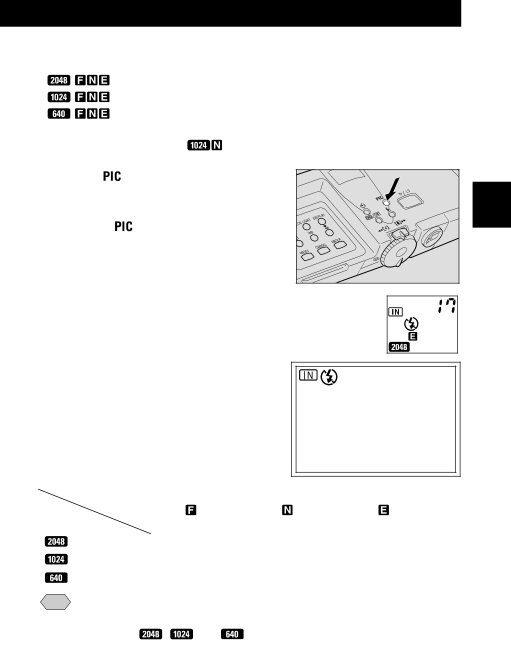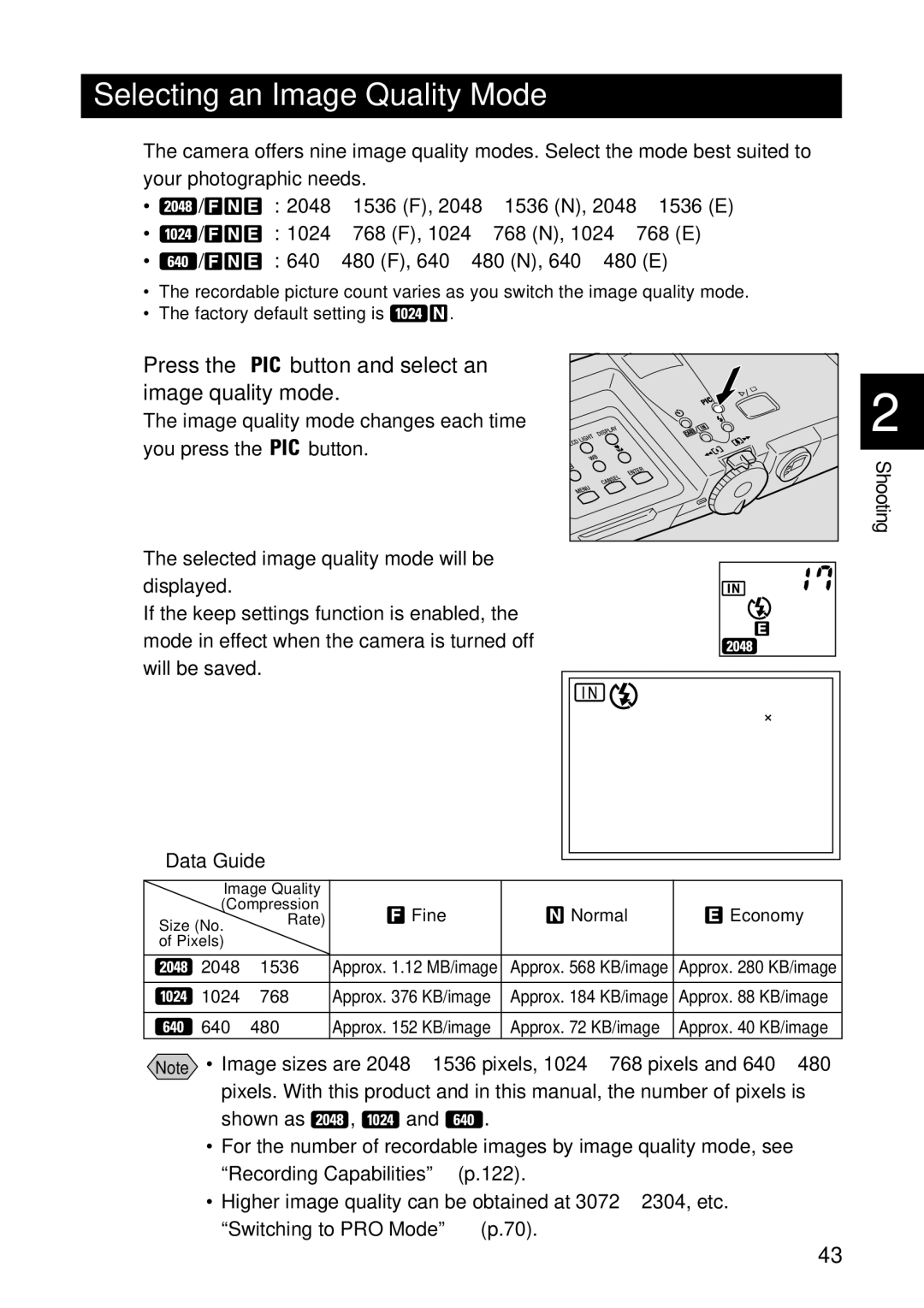Image Capturing Device
Copyright
Introduction
Contents
Erasing
Playback
Transferring Images to a PC Changing Camera Settings
SETTINGS/MISCELLANEOUS
Camera Features
Parts & Names
Camera Body Front
Back
Operation
Battery AC Adapter optional
AC-3 120V
DR-3
Information Displays
LCD Monitor
No Card
Status Explanation and Remedy Reference
Error Explanation and Remedy Reference
Error Messages
LCD Panel
Load the battery into the camera
Powering the Camera → p.22-26
Basic Operation/Quick Reference
Preparations
Basic Shooting Procedure Still Picture Mode → 41-48
Setting the Date and Time → p.34-35
Shooting
Press the shutter release button to record the image
Set the mode dial to or Press the button
Using the Self-Timer → p.59
Playback
53-55
Erasing
Erasing Files → p.92-94
Press the shutter release button
Safety Precautions
Are drawing power from a household electrical outlet, be
Turn off the power immediately if any metallic object
Sure to unplug the power cord from the outlet to avoid
Clean water for at least 15 minutes and seek medical
Substances. Consumption of battery fluid is extremely
Keep the battery used in this equipment out of the reach
Inability to read and understand warnings and safety
Precautions may lead to accidents
Electronic transformers when traveling abroad
Where usage is restricted or prohibited as this may lead
Do not use the equipment near flammable gases
Gasoline, benzine, thinner or similar substances to avoid
Damaged battery, wash the area with water immediately
Contact with fluid leaking from a battery can lead to
Do not use soap. If a battery starts to leak, remove it
Immediately from the equipment and wipe the battery
Page
Getting Started
Before Using the Camera
Checking the Package Contents
Installing the strap and lens cap
Charging the Battery
Powering the Camera
Precautions
Charge lamp Contents
Load the battery
Loading the Battery
Close the battery cover
Shooting and Playback Guidelines
Tips to Extend Recording and Playback Times
Handling Precautions
Insert the power plug into the electrical outlet
Using an AC Adapter
SmartMedia Memory Cards
What is a SmartMedia Memory Card?
Protecting Against Accidental Writing
SmartMedia Memory Cards
Inserting a SmartMedia Memory Card
Inserting Card
Data
Insert the SmartMedia memory card
Removing Card
Turn the mode dial to select the desired mode
How to Use the Mode Dial
Menu Displays
Menus
Menu Settings
Selecting, Setting and Cancelling Items
Getting Started Play Menu
Record Menu
Setting the Date and Time
Press the Enter button
Press the or button to change the flashing digit
After setting the minutes, press Enter button
How to Hold the Camera
When viewing through the viewfinder
When viewing on the LCD monitor
GettingStarted
Usage Precautions
Diopter Adjustment
Adjusting the Camera
Adjusting the Brightness of the LCD Monitor
Press the LCD Light button on the operation panel
Shooting
Operation Flow
Basic Shooting
Open the LCD monitor and press the power switch
Selecting a Shooting Mode
Auto Power Off
Set the mode dial to
Selecting a Recording Destination
Press the button and select the recording destination
LCD Monitor Display
Selecting an Image Quality Mode
Press Button and select an Image quality mode
Data Guide
Setting the Size of the Subject Zoom
Digital Zoom Function
Move the zoom lever to
Checking the Position of the Subject
Viewing Through the Viewfinder
Viewing on the LCD Monitor
Shooting Still Picture Mode
Flash LED
How to Cancel Recording
When Focusing is Difficult
Tips Using the Camera for Extended Periods of Time
Tips LCD Monitor Display Function
Special Shooting Functions
Text Shooting Text Mode
Sound Recording Sound Mode
Continuous Shooting Continuous Shooting Mode
Press the shutter release button to record
Maximum number of continuous pictures
Motion Picture Shooting Motion Picture Mode
Press the or button to select on and press the Enter button
Still Picture/Text Shooting with Sound
Changing Flash Modes
Flash mode switches each time you
Press the shutter release button to Shoot the image
Flash Strength
Adjusting the Strength of the Flash
Exposure Compensation Range
Setting the Exposure Compensation
Shooting Against the Light
Shooting a White Image
Tungsten Light
Changing the White Balance
White Balance
Using the Self-Timer
Set the mode dial to or and press the button
Tips Remote Control
Close-up Shooting Macro Mode
Set the mode dial to one Following and press the button
Shutter release button
How to Use the Focus Lock
When to Use the Focus Lock
Focus Lock Shooting
Use the zoom lever to set the size of your subject
Manual Focus Shooting
Shooting Mode 1/3
Press Button to select
Red-Eye Reduction Mode
On and press the Enter button
Will be displayed on the LCD panel or LCD monitor
Changing the ISO Setting
Date Imprinting
Press the shutter release button to take the picture
Soft Mode
Monochrome Mode
Monochrome Mode
Interval Shooting
Interval Mode
Set the mode dial to and press the Menu button
Auto Bracket Shooting
Press the shutter release button
Press the shutter release button to take the pictures
Switching to Non-Compressed Mode
No Compression
Switching to PRO Mode
PRO mode will be displayed on the LCD monitor or LCD panel
Shooting Time Data
Setting the Time Exposure Mode
Playback
Connecting to a TV
Before Starting to Playback Recorded Images
Files That Can Be Played on the Camera
Playback
Using the Camera for an Extended Period of Time
Playing Back a File
Playing Back a Still Picture/Text/Continuous File
Press the or button to select a file to be played back
Playing a Sound File
Playback Display
To pause/resume Playback
Playing a Motion Picture File
Adjusting the Volume
Still Picture/Text/Continuous File
Tips Display Function
Multi Image Playback
Special Playback Functions
Zoom Playback
After confirming the file, press Cancel button
Press the or button and the or button to verify the file
Changing the Magnification
Auto Playback
Set the mode dial to theMENUbutton Press
Rotating a Displayed File
Playback time 1 SEC., 3 SEC., 5 SEC
Copying Image Files
Playback Mode 2/2
Playing a File Shot with a Non-Ricoh Camera
Copying All Files
Copying Selected Files
Protect
Protecting a File
Setting Dpof Digital Print Order Format
Setting Printing Services
How to Unprotect a File
If Dpof has already been set
Specifying the number of prints
Specifying the Number of Index Prints
Press the Cancel button
How to Cancel the Dpof Settings
Page
Erasing
Erase Single Image
Erasing Files
Erasing
Erase All Images
Erase Selected Images
SETTINGS/MISCELLANEOUS
PC Operating Platforms and installation instruction
Installing Camera Utility Software
Transferring Images to a PC
Windows
Settings/Miscellaneous
Connecting the Camera to a PC
Formatting a Card/Internal Memory
Changing Camera Settings
Keep Settings
Set the mode dial to Press the or button to select
Auto Power Off Setting
Changing LCD Confirmation Time
100
Power Save Mode Setting
Beep Sound Setting
Set the mode dial to SET Press the and buttons to select
101
When Sequential NO. is OFF
When Sequential NO. is on
File Numbering System
102
Changing Video-Out Signal Method NTSC/PAL
Changing Display Language
103
104
Initializing Settings
105
Using the Remote Control
Setting Exposure Compensation
Shooting in Manual Focus Mode
Playing
Magnifying an Image Zoom Playback
How to Cancel Zoom Playback Mode Press the Program button
Displaying Multiple Images Multi Image Playback
Press the Multi button
Erasing All Files
Erasing Selected Images
108
Appendix
110
Accessories
Handling Precautions
111
Appendix
Care
Care and Storage
Storage
112
Power Source
Troubleshooting
113
Recording and Playback
114
115
Miscellaneous
116
117
Using Your Digital Camera in Other Countries
118
About the Warranty and Servicing
119
120
Specifications
RS-232C/AUX/USB
121
122
Recording Capacities
123
USA FCC Part15 Class B
124
Ricoh Service Offices

